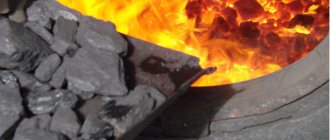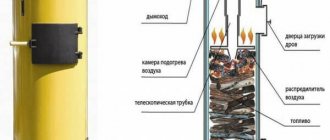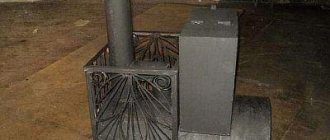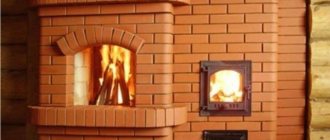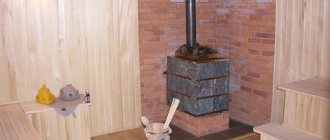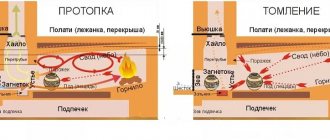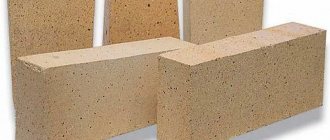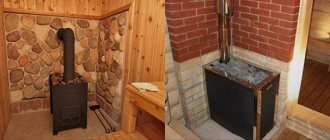The choice of heating equipment often confuses private homeowners. The hardest thing is for those who do not have practical experience in its operation. A person who has lived in an apartment since birth and then decided to build his own country house or dacha most often has no idea what is better - a stove or a boiler.
The employees of the largest heating and bathing equipment store in Novosibirsk will help us deal with this issue. The company, which will celebrate its 10th anniversary this year, supplies stoves, fireplaces, boilers and chimney systems from leading manufacturers, and the opinions of its experts are trusted by private homeowners throughout Russia.
Boiler and furnace: difference in heat transfer
One of the main differences between a furnace and a boiler is the way heat is transferred into the rooms. These features affect the rate at which rooms warm up and heat distribution.
In stove heating, the coolant is air. It heats up from the walls of the firebox and forms a convection flow. In addition, part of the heat from the stove is released in the form of infrared radiation, which is transmitted into the room. The intensity of IR rays decreases with distance from the firebox. Blank walls are an insurmountable barrier to air convection and a screen for thermal radiation. To heat a house consisting of several rooms, the stove is sometimes placed in the wall opening that separates the rooms. Some manufacturers offer models with heat sinks and flexible air ducts, through which some of the warm air can be redirected to other rooms. There are duct systems for natural and forced circulation, which are hidden in the interceiling space, but their design and implementation turn out to be expensive.
The stove begins to produce heat immediately after ignition, and the house becomes comfortable within 30 - 40 minutes.
The boiler uses water (or antifreeze) as a coolant. This makes it possible to deliver heat to the most remote corners of the house. But in order for the radiators to start giving off heat, the coolant must first warm up. Even with intense combustion, the walls of the boiler remain cold - thermal radiation from it is minimal. Depending on the power of the firebox, the initial temperature in the rooms and the volume of the heating system, warming up the rooms may take several hours.
Solid fuel boilers: their advantages and disadvantages
An alternative to massive brick stoves are solid fuel boilers with a water circuit.
This heating device is selected by power, depending on the heated area and the climate of the region. So for regions in the central part of Russia, a 20 kW boiler is more than enough to heat 100 sq.m of living space.
Heat from a solid fuel boiler will cost slightly more than heating with gas from the main gas pipeline, but is disproportionately cheaper than heating with electricity. You can install this heating device in place and piping it yourself - which is undoubtedly convenient and saves the family budget.
Another advantage of solid fuel boilers is that they are “omnivorous” in terms of solid fuel options. You can even use sawdust. Many of them are equipped with electric heaters and even gas burners, allowing you to switch to other types of fuel if necessary. Plus, you can choose a completely energy-independent model.
However, these devices also have a whole group of disadvantages:
- It is necessary to provide a separate room in the house to accommodate a solid fuel boiler and all related units;
- A solid fuel boiler will have to be regularly cleaned of soot, soot and ash;
- The device requires frequent participation of the homeowner: regular manual loading of the firebox is required, approximately every 2 hours;
- Such boilers have low efficiency. Most of the fuel is wasted;
- As practice shows, installing a forced draft device for solid fuel boilers is simply necessary.
Features of equipment installation
It is believed that a boiler is a compact installation compared to a furnace, and it will be much easier to put it into operation. If we are talking about a classic brick oven, then this opinion is absolutely fair. Due to the massiveness of the firebox and chimney, installation begins with the zero-cycle work, that is, with the arrangement of the foundation. It will not be easy to find a competent stove-maker: specialists have a schedule of orders scheduled months in advance, and a mason who has only been involved in general construction work is unlikely to cope with this task.
A modern metal stove is much easier to install. In most cases, it can be installed on the ceiling (in compliance with fire safety standards).
With a boiler, everything will be much more complicated, and the newer it is, the more equipment needs to be installed and connected. The list of components for a typical solid fuel system will include:
- circulation pump;
- hydraulic separator;
- buffer capacity (not mandatory, but highly desirable element);
- security group; expansion tank.
A prerequisite for installing a boiler is the presence of a separate boiler room. The stove is usually placed in the largest room by area. And here it is important that it fits into its design. Fortunately, stove manufacturers pay a lot of attention to this issue, and most modern models look aesthetically pleasing and attractive.
One of the varieties of such equipment is a fireplace stove. The closed firebox is equipped with a large viewing glass. Many models have a long burning function.
FAST
SEO optimization
Adaptive layout
Repair in the regions
- home
- Articles
- Heating
- Furnace or boiler
The choice of heating equipment often confuses private homeowners. The hardest thing is for those who do not have practical experience in its operation. A person who has lived in an apartment since birth and then decided to build his own country house or dacha most often has no idea what is better - a stove or a boiler.
The employees of the largest heating and bathing equipment store in Novosibirsk will help us deal with this issue. The company, which will celebrate its 10th anniversary this year, supplies stoves, fireplaces, boilers and chimney systems from leading manufacturers, and the opinions of its experts are trusted by private homeowners throughout Russia.
Fuel and operating modes
When choosing between a furnace and a heating boiler, factors of cost and fuel availability must be taken into account. Natural gas is undoubtedly considered the cheapest, but only if it is already supplied to the house. Otherwise, the cost of permits, work, gas heating project, equipment maintenance will be astronomical. The investment will pay off gradually over a few years.
A solid fuel boiler or stove can be installed without obtaining permits or concluding service contracts. In this case, responsibility for safe operation falls entirely on the owner of the house. The difference between them is that most metal stoves can only be heated with wood. The higher specific heat release of other types of solid fuel will cause thermally loaded areas to quickly burn out.
The boilers are distinguished by their fuel versatility. They can burn wood, coal, fuel briquettes and pellets. The water jacket surrounding the boiler firebox on all sides absorbs a large amount of heat. The metal walls do not have time to heat up to temperatures at which the metal begins to intensively oxidize.
Ovens are designed for intermittent operation unless otherwise stated in the user manual. Consultants of the Fornax online store always warn customers about this point: with continuous combustion of fuel, the metal walls of the firebox will quickly burn out.
It is better to operate the boiler in constant mode. It is started at the beginning of the heating season and stopped in the spring, when it becomes warm enough outside. It can also be used for periodic operation, but it must have an antifreeze function (and only gas and electric boilers have it), or the heating system must be filled with antifreeze. Note that many manufacturers refuse a warranty if there was anti-freeze liquid in the boiler.
What is better: stove or water heating of a private house? on the Nedvio website
- Real estate
- Construction
- Repair
- Plot and Garden
- About country life
- Questions and Answers Interactive cadastral map
- About the Nedvio project
- Advertising on Nedvio.com
Despite huge gas reserves and many pipelines, most small Russian settlements located far from large cities are unlikely to ever be gasified. It's simply not profitable. Even in the heart of Russia, 200 km from Moscow, only those towns and villages that are located no further than 10-15 km from cities are gasified. Then everything is like in the remote taiga. The only difference is that there is electricity.
The climate in Russia is harsh, and our cold season lasts 7-8 months. That is why well-established and inexpensive heating in a private home is a vital living condition. In the absence of cheap gas, two suitable fuel options remain: electricity and all types of solid fuels.
Electricity is a very expensive means of heating a private home, and far from safe, although very convenient. What remains are the good old firewood and their modern analogues: briquettes and pellets. Although they are also becoming more expensive. Who knows, maybe in a couple of years the cost of preparing firewood for the coming winter will be comparable to the cost of electricity and lying on a warm stove in your house, as in Russian fairy tales, will become too expensive.
When building a house, you need to decide what is better to choose for heating: a solid fuel hot water boiler or a brick stove, which is traditionally equipped in many village houses. And in order to make the right decision, you should consider in more detail the pros and cons of both options.
Heat regulation
The presence of a buffer tank (heat accumulator) in the system plays an important role in heat absorption. This device allows you to smooth out peak heat release during intense fuel combustion. All the heat absorbed by it is returned to the heating system after the fill burns out. One of the important advantages of a boiler in conjunction with a heat accumulator is that this process can be automated. The hydraulic separator (hydraulic arrow) allows you to separate the boiler circuit from the heating circuit and supply the latter with exactly as much heat as is needed to maintain a comfortable temperature in the rooms. Of course, this causes a slight increase in the cost of the heating system.
Furnaces also have temperature control capabilities, but they are much more modest. Heat dissipation can be adjusted in much smaller ranges and only manually. Many stoves have a long-burning function, where the wood smolders for several hours. However, the subsequent filling must be burned intensively so that soot and tar deposits do not accumulate in the chimney. In any case, fuel combustion in the stove will be accompanied by temperature fluctuations in the rooms. And each stove owner will have to develop a fuel filling schedule and experimentally determine the optimal positions of the dampers. Although production models are the same, the volumetric heating value of firewood can vary greatly.
Thus, the boiler provides a more balanced microclimate in the house.
Which is better: a brick stove or a boiler?
The approaching cold weather is forcing residents of Buryatia who are building a private house to quickly decide on heating their homes. And therefore, first of all, you need to carefully consider which heating will be most optimal for your home - a simple stove or boiler
The approaching cold weather is forcing residents of Buryatia who are building a private house to quickly decide on heating their homes
Of course, everyone wants it to not require large material costs and physical effort and to be warm and cozy. And therefore, first of all, you need to carefully consider which heating will be most optimal for your home - a simple stove or boiler. And if it’s a boiler, then what fuel does it use – solid, liquid, electricity or gas?
Everything will depend on the size of your home and your financial capabilities. And therefore, “Windows of Buryatia” decided to collect for our readers the opinions of people who have already encountered such a problem, and asked them to share their experience, tell what they were guided by when choosing a certain type of heating.
“There is nothing more reliable than a stove”
Stove on two floors
Ulan-Ude resident Dashima Dugarova lives in a two-story comfortable house on Zelenkhoz. The house measures 7 by 8 meters on two floors, approximately 110 square meters, and is heated by a conventional stove. The sides of the stove open into all rooms of the house. On the ground floor there is a large entrance hall, where the stove itself is located, a kitchen combined with a living room, a bathroom and a toilet. By the way, they are heated with electricity (warm floors – Note “OB”). On the second floor there are two large, bright bedrooms and a small hall.
“When my husband and I were thinking about what kind of heating to choose, we decided that nothing had yet been invented more reliable and cheaper than a simple stove,” shares the owner of the house.
They believe that in any unforeseen situations: there is no light, electricity, gas or liquid fuel prices rise, etc., the stove will never let them down. After all, we don’t have any problems with firewood in Buryatia yet.
Autonomy
Unlike a completely self-contained furnace, most boilers require electricity to operate. Even models with non-volatile automation eventually turn out to be dependent on electricity: at least one circulation pump will need power. Modern gas boilers require stable and high-quality mains voltage.
A power outage, surge or drawdown will cause the boiler to “go into error”, that is, turn off the main burner and require a manual restart. The heating system will begin to cool down, and even in a well-insulated house, after 2–3 days the temperature will be equal to the street temperature. If the owners are not on site at this time, the water circuit may freeze, which will ultimately lead to large-scale repairs: replacing radiators, pipes or the heat exchanger of the boiler itself.
For trouble-free operation of heating in a house with temporary residence, you will need to organize an uninterruptible power supply system or use non-freezing liquid as a coolant. And these are additional costs. In addition, most gas boilers cannot be operated with antifreeze in CO.
Assembly of the structure
Assembling the radiators together is not difficult, but you should first purchase new intersection gaskets or use instead an asbestos cord impregnated with graphite powder, previously diluted in drying oil.
Since the temperature inside the boiler can exceed +600 degrees, it is worth taking care of the gaskets in advance. The tightness of the entire structure depends on their quality and strength.
The radiator assembly sequence is as follows:
- Nipples equipped with right and left threads are screwed into each section.
- Asbestos cords are wound around them.
- The sections are connected in pairs by alternately tightening the nipples. It is important to make the same number of turns with the key so as not to cause distortion.
- All sections of the cast iron radiator are connected in the same way.
- The return and supply pipes should be connected diagonally, closing unused holes with plugs.
On one side of the riser there should be a right-hand thread, and on the other, a left-hand thread. If this does not work out, then you need to screw on the nipple and the coupling with the drive on it.
Conclusion
It is possible to say unequivocally what is better - a stove or a boiler (solid fuel, gas or electric) only in relation to specific operating conditions. Here we can only summarize general points. It is preferable to install stoves in small buildings with irregular occupancy. They quickly warm up the room and do not require supervision after stopping. They can also be used as an additional or backup heating source.
Boilers are more often used in large houses with permanent residence. The water heating system effectively heats two-story buildings and provides good heat distribution over height. And with correctly configured circulation, the temperature in the room does not depend on its distance from the boiler room.
We recorded a video in which we clearly examined a number of important points, in our opinion, in choosing between a stove and a heating boiler. And if you still have questions, you can ask us on the official website or by phone.
So what should you choose?
It all depends on the goals. If fire safety is important to you, give preference to a solid fuel hot water boiler. It is installed either in a separate building or in a room separated from the house by a brick main wall. And the heating of the interior is carried out through pipes using hot water.
If it is important for you to constantly have a warm home, opt for a brick stove. The main disadvantage of any water heating system is its low inertia in retaining heat. When the combustion in the boiler stops, within an hour you will feel an unpleasant coolness in the house. Then the oven will retain heat for at least half a day. You need to be prepared for the fact that you will have to fire a solid fuel boiler around the clock to maintain a comfortable temperature in the house. While it will be enough to heat a stove (especially a Russian one) in the morning and evening. This will provide the house with heat for the whole day.
As for ease of use, the stove looks like a more practical solution. A solid fuel boiler will require several times more firewood for the heating season compared to a stove. It is difficult to heat a boiler with raw wood, but this can be done with stove heating. The boiler is very sensitive to weather conditions in terms of draft, much more sensitive than a brick stove.
As you can see, despite all the progress in technology, stove heating still has many advantages over the more modern type of heating using a solid fuel hot water boiler. And, perhaps, its most serious drawback is the high fire hazard of stoves.
You can protect a wooden house from fire by complying with all safety standards and rules that every owner of a house with stove heating should know. All structures in contact with the stove and located in close proximity to it must be under the constant supervision of people living in the house. In fact, this is not difficult, but many homeowners forget about it, which in no case should be done.
Don't forget to add the Nedvio website to your Bookmarks. We talk about construction, renovation, and country real estate in an interesting, useful and understandable way.
What are the pros and cons of a potbelly stove, how much will it cost?
The biggest advantage of a regular potbelly stove is its price. In the store it starts from 2000 rubles (without pipes). When I was choosing a potbelly stove for the barn, I paid 5,000 rubles for it, and I also bought pipes and elbows (for about 2,000 rubles).
The potbelly stove also has the following advantages:
- cheap fuel;
- ease of installation;
- ease of heating;
- rapid heating of the room.
Of the main disadvantages, I noted the following:
- very dirty around the stove;
- it is necessary to arrange special outlets near the pipe, as it gets very hot;
- the oven heats up quickly, but cools no less quickly;
- When the stove is burning, it is very hot near it.
The potbelly stove that I had.
Exhaust furnace made of cast iron radiator
It’s better to start preparing for winter long before it arrives, and now you can arrange your workspace in the garage or other necessary room. This will help not only with time-tested stove designs that you will find on our website, but also with new ideas.
The development of the exhaust furnace, carried out by A. Polulyakh, consists of a conventional cast iron radiator MS-140, a freon tank, and a chimney for exhaust gas discharge outside the room.
Products for inventors. Link to the store.
What is the idea behind this stove design? There is a freon tank with a lid at the top of it. The waste is poured inside. At the bottom of the tank there is a tap to which a copper tube is connected, which supplies hot gas to the battery. The battery has 5 sections, which should be limited to, since the sixth section will heat up very little and its efficiency will be low. The radiator stands on a base of two bricks.
Fuel combustion occurs in the lower part of the first two sections of the battery. The burned hot gas disperses throughout all sections; it rises upward through convection and primary pressure, but the heating of the first two sections, naturally, occurs much more strongly. The upper part of the battery heats up within 70-80 degrees, and the bottom becomes red-hot.
The fuel consumption for this radiator furnace is small - approximately 1.5-2 liters of waste oil. The chimney, like the entire structure of the stove, is also simple. At the top it goes out through the wall onto the street, protruding 50 centimeters above the roof so as not to be blown by the wind.
DIY electronics in a Chinese store.
The furnace is initially ignited using gas. Within 5 minutes, gas is launched from a propane cylinder through the cutter. It slightly warms up the stove in the combustion chamber, that is, the part where fuel can then be injected, which, entering in drops through a copper tube, is ignited by the fire at the outlet of the cutter and then works for spontaneous combustion. The design presented in this article uses air injection from a compressor.
As for the advice to dry clothes on such a stove, for safety reasons it is necessary to do this only on an extinguished stove. Under no circumstances should you splash water on a cast iron battery!!! Hot cast iron bursts instantly!
Below is another video in which the author demonstrates the ignition and operation of this stove. He placed metal shavings (stainless steel) into the combustion chamber to speed up ignition. You can see how drops of oil fall on the chips, turning into flames. Warming up with chips takes just a few minutes. Blowing air also helps to warm up the oven.
Discussion
Alexey Timofeev Well done! I like this better than what was proposed and seen earlier on YouTube. There is a very important question: with a certain calcination (operation time of the furnace-radiator), the metal will not become too brittle? Although this will probably concern the corner points of the battery where the highest temperatures are observed, and not the entire area of the radiator-stove. There is a proposal that if the fuel does not completely burn out in the radiator stove, then you can make an additional air supply inside the radiator itself, through a special tube, to the upper outlet point of the radiator, where the radiator meets the chimney. Plus, in the same place, you can install special blades that will swirl the escaping gases (those that used to go directly into the chimney, it seems to me more favorable in a right-handed spiral), and mix them with clean air coming from an additional air duct (the one who suggested bringing it through a separate tube , laying it inside the radiator itself), but it is necessary, I assume, to make an additional cylinder for the operation of this afterburner of exhaust gases. There are tips on this topic on YouTube - “rocket stove” (there is about supplying additional air for the combustion of gases). If there is a desire to increase heat generation beyond the current norm, you can add water dropwise to the system, on a special evaporator (you need to think about it - or look at Valery Dudyshev - as far as I know, water, if overheated, can burn, but this The fire is very hot - a mixture of hydrogen and oxygen.
Alexander Polulyakh Thank you very much for your practical advice. Regarding brittleness and hardening, I don’t think anything will happen to cast iron. Crucibles are made on its basis and it is not afraid of high temperatures. Yes, with butter! You are one hundred percent right. I poured the waste from under the machine into a tray, there is oil and water, well, in short, an emulsion. So it burns three times more efficiently than just working without water! Water, as it were, dilutes the fuel and thereby saturates it with a greater oxygen mixture in the combustion chamber.
Gennady Volkov 4 years ago +Alexander Polulyakh Water promotes better atomization of oil. The oil envelops a drop of water and the resulting steam breaks long chains of hydrocarbons into smaller ones that burn better.
Alexey Timofeev + Gennady Volkov plus this, and also superheated steam, I heard from the outside that it itself can burn like fuel, from personal experience I observed how droplets of water falling on a hot burner of a gas stove, when its flame was working, changed the color of the flame from blue to orange, from which I assume that an additional flammable mixture of oxygen + hydrogen (from superheated steam) has formed.
Gennady Volkov Direct thermal decomposition of water occurs at a temperature of 3000K. There are no such temperatures even close here.
Regarding cleaning the radiator from hardened deposits/carbon deposits. — There is a method of cleaning with electric water hammer (called the Yutkin effect, you just have to be careful, it uses high-voltage pulsed discharges, you know what you’re dealing with. Plus, what’s also important to consider with this cleaning method is that the battery itself may turn out to be fragile and sharp for such (shock) ) cleaning method and may break/crack (either the power of the blows must be known in advance and not exceed this value, or another cleaning method must be found).
Alexander Bestaev Pressure, not pressure - this is all good, of course, but if you make turns, then either you need to constantly supply oil, and this is impossible, because the stove must sometimes be turned off, or the tube will soon become clogged with oil deposits. Even without coils, it can get clogged at the outlet, but without coils, I stuck a screwdriver in there, and the oil flowed again, but you can’t do that with coils. Theory without practice is dead!
Evgeniy Leonov The stove is super. Cleaning is no problem, like a muffler on a scooter. fill Mr. Muscle overnight…. Lightly tap with a hammer and rinse. came up with a problem. inflation is also not a problem. Cooler from PC and power supply from charging bodies. The main thing is to tighten the fins or come up with airflow to the battery for good heat transfer. Good use of an unnecessary battery. Despite the fact that there is almost no need to cook as in other designs. Well done author!
Alexandr Yu 1.5 - 2 liters per day? Are you confusing anything? Typically 1 liter per hour. If we consider that during a working day (8 hours) only 2 liters of waste are burned, then I throw out all my wood stoves.
Alexander Polulyakh I fill 2 liters of emulsion from under a lathe. Enough for a working day. It's dripping slowly. At this flow rate it does not heat up until red hot, but sufficient heat comes out - the output is 40 degrees. It’s enough to warm your hands and dry your gloves.
Alexandr Yu Do you think about trying to drill holes at the bottom of the vertical part of the first section and at the bottom of the horizontal part between the first and second sections - for the intake of explosives, increasing the efficiency?
Alexander Polulyakh It won't be any worse! But I always have compressed air in the garage, so I don’t need it. I do a little forced blowing. Fuel burns more efficiently.
4x4 Bratsk I think that this stove can only heat itself. Just enough to warm your hands. What if the temperature outside the garage is at least -20? Plus the garage cooled down overnight. How long will you heat it with your stove, at least just to above-zero temperature? I think by the end of the working day, steam will stop coming out of my mouth.
Vasily Vinyarsky + Alexander Shamardin you probably want to heat a metal garage.
4x4 Bratsk No, concrete. And when using the stove during testing, with a flow rate of approximately 1 l/hour, you can work normally in the garage in winter, even if it gets a little hot. And what is shown here is sticky. Just to dry the mittens, or as a supplement to another heat source.
Vasily Vinyarsky +Alexander Shamardin agrees with you in this form. But if you put this battery in a closed casing with two holes. There is a fan in one, hot air from the other, and at the ceiling a low-speed bladed fan for pushing warm air down is a completely different matter.
4x4 Bratsk With a fan, of course, it will be a completely different matter. But do not forget that when the waste is burned, a large amount of soot is formed, and if cleaning a “traditional” stove during waste is not a problem, then with a radiator, everything is much more complicated. Accordingly, heat transfer will decrease... not to mention the draft.

